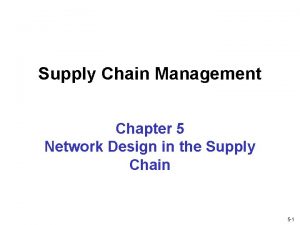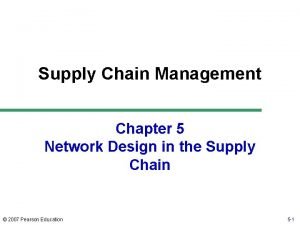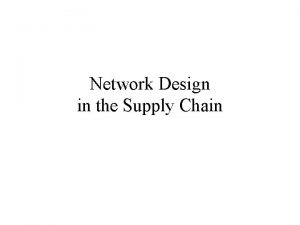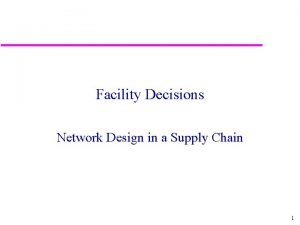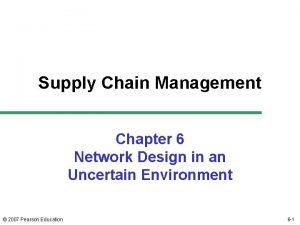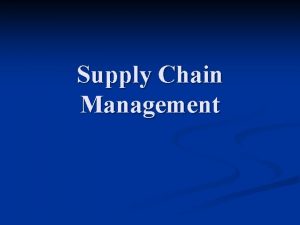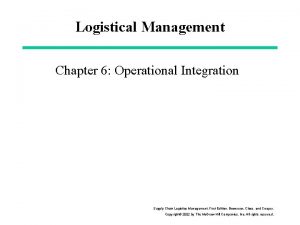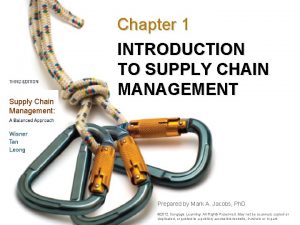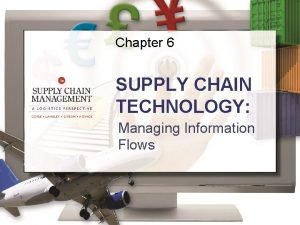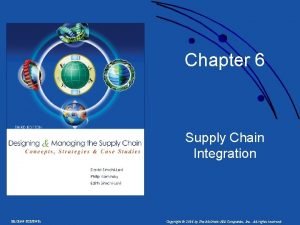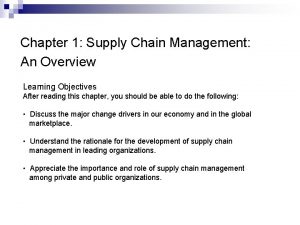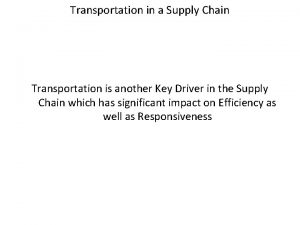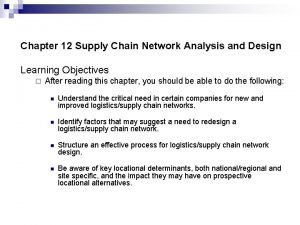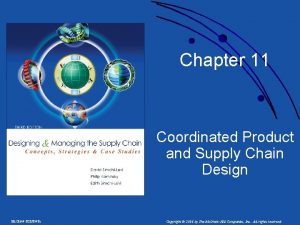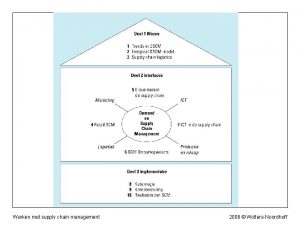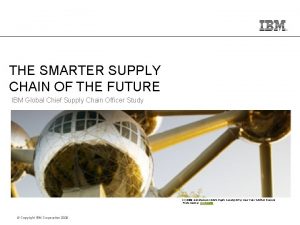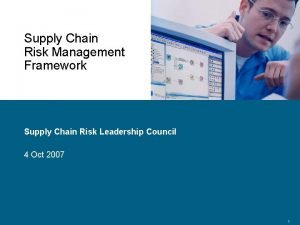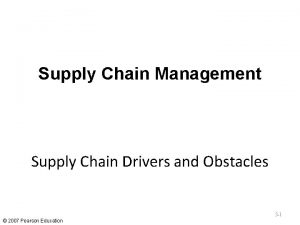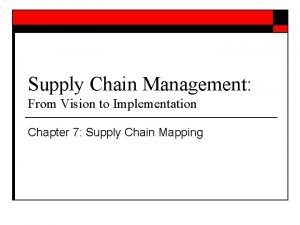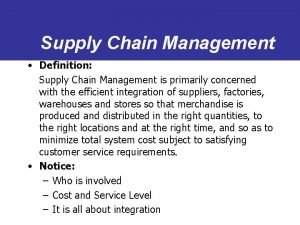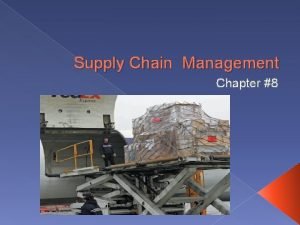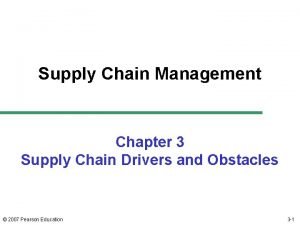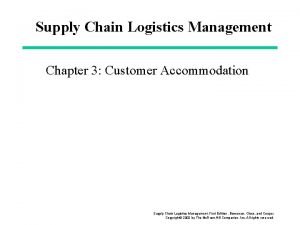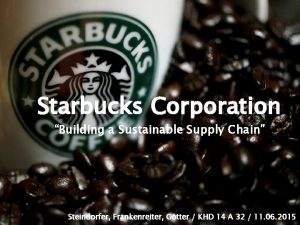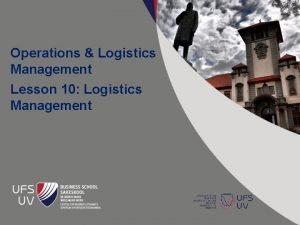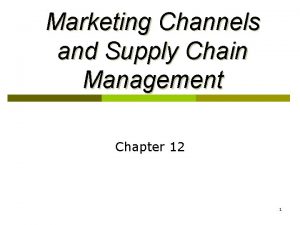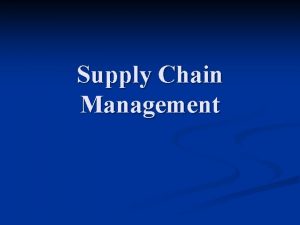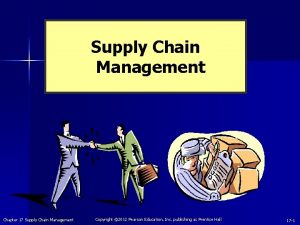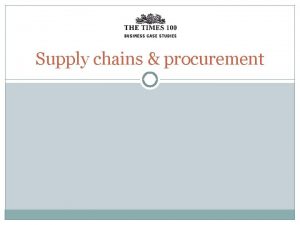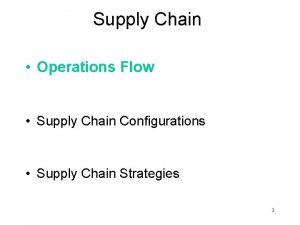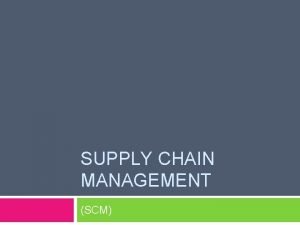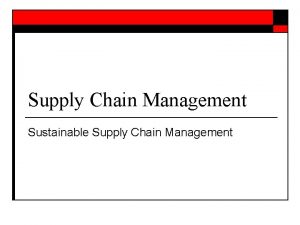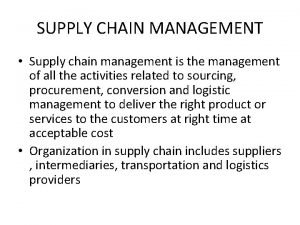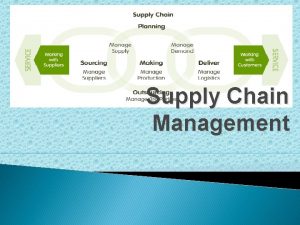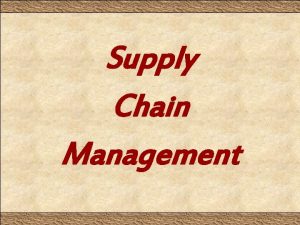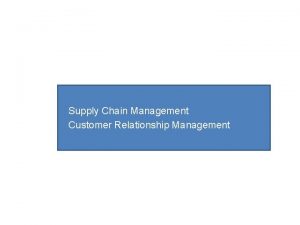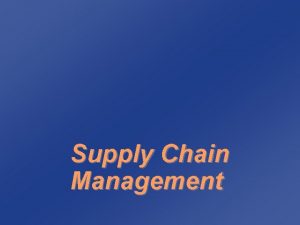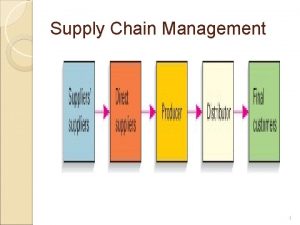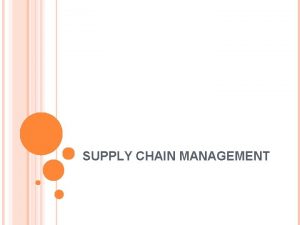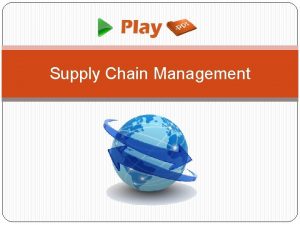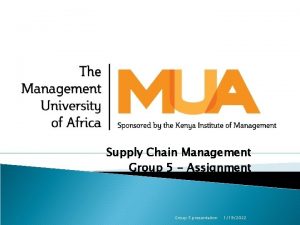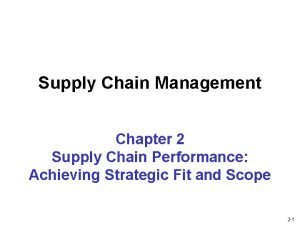Supply Chain Management Chapter 6 Network Design in


































- Slides: 34

Supply Chain Management Chapter 6 Network Design in an Uncertain Environment © 2007 Pearson Education 6 -1

Outline u. The Impact of Uncertainty on Network Design Decisions u. Discounted Cash Flow Analysis u. Representations of Uncertainty u. Evaluating Network Design Decisions Using Decision Trees u. AM Tires: Evaluation of Supply Chain Design Decisions Under Uncertainty u. Making Supply Chain Decisions Under Uncertainty in Practice u. Summary of Learning Objectives © 2007 Pearson Education 6 -2

The Impact of Uncertainty on Network Design u. Supply chain design decisions include investments in number and size of plants, number of trucks, number of warehouses u. These decisions cannot be easily changed in the shortterm u. There will be a good deal of uncertainty in demand, prices, exchange rates, and the competitive market over the lifetime of a supply chain network u. Therefore, building flexibility into supply chain operations allows the supply chain to deal with uncertainty in a manner that will maximize profits © 2007 Pearson Education 6 -3

Discounted Cash Flow Analysis u. Supply chain decisions are in place for a long time, so they should be evaluated as a sequence of cash flows over that period u. Discounted cash flow (DCF) analysis evaluates the present value of any stream of future cash flows and allows managers to compare different cash flow streams in terms of their financial value u. Based on the time value of money – a dollar today is worth more than a dollar tomorrow © 2007 Pearson Education 6 -4

Discounted Cash Flow Analysis • Compare NPV of different supply chain design options • The option with the highest NPV will provide the greatest financial return © 2007 Pearson Education 6 -5

NPV Example: Trips Logistics u. How much space to lease in the next three years u. Demand = 100, 000 units u. Requires 1, 000 sq. ft. of space for every 1, 000 units of demand u. Revenue = $1. 22 per unit of demand u. Decision is whether to sign a three-year lease or obtain warehousing space on the spot market u. Three-year lease: cost = $1 per sq. ft. u. Spot market: cost = $1. 20 per sq. ft. uk = 0. 1 © 2007 Pearson Education 6 -6

NPV Example: Trips Logistics For leasing warehouse space on the spot market: Expected annual profit = 100, 000 x $1. 22 – 100, 000 x $1. 20 = $2, 000 Cash flow = $2, 000 in each of the next three years © 2007 Pearson Education 6 -7

NPV Example: Trips Logistics For leasing warehouse space with a three-year lease: Expected annual profit = 100, 000 x $1. 22 – 100, 000 x $1. 00 = $22, 000 Cash flow = $22, 000 in each of the next three years The NPV of signing the lease is $54, 711 higher; therefore, the manager decides to sign the lease However, uncertainty in demand costs may cause the manager to rethink his decision © 2007 Pearson Education 6 -8

Representations of Uncertainty u. Binomial Representation of Uncertainty u. Other Representations of Uncertainty © 2007 Pearson Education 6 -9

Binomial Representations of Uncertainty u When moving from one period to the next, the value of the underlying factor (e. g. , demand or price) has only two possible outcomes – up or down u The underlying factor moves up by a factor or u > 1 with probability p, or down by a factor d < 1 with probability 1 -p u Assuming a price P in period 0, for the multiplicative binomial, the possible outcomes for the next four periods: – Period 1: Pu, Pd – Period 2: Pu 2, Pud, Pd 2 – Period 3: Pu 3, Pu 2 d, Pud 2, Pd 3 – Period 4: Pu 4, Pu 3 d, Pu 2 d 2, Pud 3, Pd 4 © 2007 Pearson Education 6 -10

Binomial Representations of Uncertainty u. In general, for multiplicative binomial, period T has all possible outcomes Putd(T-t), for t = 0, 1, …, T u. From state Puad(T-a) in period t, the price may move in period t+1 to either – Pua+1 d(T-a) with probability p, or – Puad(T-a)+1 with probability (1 -p) u. Represented as the binomial tree shown in Figure 6. 1 (p. 140) © 2007 Pearson Education 6 -11

Binomial Representations of Uncertainty u. For the additive binomial, the states in the following periods are: – – Period 1: Period 2: Period 3: Period 4: P+u, P-d P+2 u, P+u-d, P-2 d P+3 u, P+2 u-d, P+u-2 d, P-3 d P+4 u, P+3 u-d, P+2 u-2 d, P+u-3 d, P-4 d u. In general, for the additive binomial, period T has all possible outcomes P+tu-(T-t)d, for t=0, 1, …, T © 2007 Pearson Education 6 -12

Evaluating Network Design Decisions Using Decision Trees u A manager must make many different decisions when designing a supply chain network u Many of them involve a choice between a long-term (or less flexible) option and a short-term (or more flexible) option u If uncertainty is ignored, the long-term option will almost always be selected because it is typically cheaper u Such a decision can eventually hurt the firm, however, because actual future prices or demand may be different from what was forecasted at the time of the decision u A decision tree is a graphic device that can be used to evaluate decisions under uncertainty © 2007 Pearson Education 6 -13

Decision Tree Methodology 1. Identify the duration of each period (month, quarter, etc. ) and the number of periods T over the which the decision is to be evaluated. 2. Identify factors such as demand, price, and exchange rate, whose fluctuation will be considered over the next T periods. 3. Identify representations of uncertainty for each factor; that is, determine what distribution to use to model the uncertainty. 4. Identify the periodic discount rate k for each period. 5. Represent the decision tree with defined states in each period, as well as the transition probabilities between states in successive periods. 6. Starting at period T, work back to period 0, identifying the optimal decision and the expected cash flows at each step. Expected cash flows at each state in a given period should be discounted back when included in the previous period. © 2007 Pearson Education 6 -14

Decision Tree Methodology: Trips Logistics u Decide whether to lease warehouse space for the coming three years and the quantity to lease u Long-term lease is currently cheaper than the spot market rate u The manager anticipates uncertainty in demand spot prices over the next three years u Long-term lease is cheaper but could go unused if demand is lower than forecast; future spot market rates could also decrease u Spot market rates are currently high, and the spot market would cost a lot if future demand is higher than expected © 2007 Pearson Education 6 -15

Trips Logistics: Three Options u. Get all warehousing space from the spot market as needed u. Sign a three-year lease for a fixed amount of warehouse space and get additional requirements from the spot market u. Sign a flexible lease with a minimum change that allows variable usage of warehouse space up to a limit with additional requirement from the spot market © 2007 Pearson Education 6 -16

Trips Logistics u 1000 sq. ft. of warehouse space needed for 1000 units of demand u Current demand = 100, 000 units per year u Binomial uncertainty: Demand can go up by 20% with p = 0. 5 or down by 20% with 1 -p = 0. 5 u Lease price = $1. 00 per sq. ft. per year u Spot market price = $1. 20 per sq. ft. per year u Spot prices can go up by 10% with p = 0. 5 or down by 10% with 1 -p = 0. 5 u Revenue = $1. 22 per unit of demand u k = 0. 1 © 2007 Pearson Education 6 -17

Trips Logistics Decision Tree (Fig. 6. 2) Period 2 Period 1 Period 0 0. 25 D=120 p=$1. 32 0. 25 D=100 p=$1. 20 D=120 p=$1. 08 0. 25 D=80 p=$1. 32 D=144 p=$1. 45 D=144 p=$1. 19 D=96 p=$1. 45 D=144 p=$0. 97 D=96 p=$1. 19 D=96 p=$0. 97 D=64 p=$1. 45 D=64 p=$1. 19 D=64 p=$0. 97 © 2007 Pearson Education 6 -18

Trips Logistics Example u. Analyze the option of not signing a lease and obtaining all warehouse space from the spot market u. Start with Period 2 and calculate the profit at each node u. For D=144, p=$1. 45, in Period 2: C(D=144, p=1. 45, 2) = 144, 000 x 1. 45 = $208, 800 P(D=144, p =1. 45, 2) = 144, 000 x 1. 22 – C(D=144, p=1. 45, 2) = 175, 680 -208, 800 = -$33, 120 u. Profit at other nodes is shown in Table 6. 1 © 2007 Pearson Education 6 -19

Trips Logistics Example u. Expected profit at each node in Period 1 is the profit during Period 1 plus the present value of the expected profit in Period 2 u. Expected profit EP(D=, p=, 1) at a node is the expected profit over all four nodes in Period 2 that may result from this node u. PVEP(D=, p=, 1) is the present value of this expected profit and P(D=, p=, 1), and the total expected profit, is the sum of the profit in Period 1 and the present value of the expected profit in Period 2 © 2007 Pearson Education 6 -20

Trips Logistics Example u From node D=120, p=$1. 32 in Period 1, there are four possible states in Period 2 u Evaluate the expected profit in Period 2 over all four states possible from node D=120, p=$1. 32 in Period 1 to be EP(D=120, p=1. 32, 1) = 0. 25 x. P(D=144, p=1. 45, 2) + 0. 25 x. P(D=144, p=1. 19, 2) + 0. 25 x. P(D=96, p=1. 45, 2) + 0. 25 x. P(D=96, p=1. 19, 2) = 0. 25 x(-33, 120)+0. 25 x 4, 320+0. 25 x(-22, 080)+0. 25 x 2, 880 = -$12, 000 © 2007 Pearson Education 6 -21

Trips Logistics Example u The present value of this expected value in Period 1 is PVEP(D=12, p=1. 32, 1) = EP(D=120, p=1. 32, 1) / (1+k) = -$12, 000 / (1+0. 1) = -$10, 909 u The total expected profit P(D=120, p=1. 32, 1) at node D=120, p=1. 32 in Period 1 is the sum of the profit in Period 1 at this node, plus the present value of future expected profits possible from this node P(D=120, p=1. 32, 1) = [(120, 000 x 1. 22)-(120, 000 x 1. 32)] + PVEP(D=120, p=1. 32, 1) = -$12, 000 + (-$10, 909) = -$22, 909 u The total expected profit for the other nodes in Period 1 is shown in Table 6. 2 © 2007 Pearson Education 6 -22

Trips Logistics Example u For Period 0, the total profit P(D=100, p=120, 0) is the sum of the profit in Period 0 and the present value of the expected profit over the four nodes in Period 1 EP(D=100, p=1. 20, 0) = 0. 25 x. P(D=120, p=1. 32, 1) + = 0. 25 x. P(D=120, p=1. 08, 1) + = 0. 25 x. P(D=96, p=1. 32, 1) + = 0. 25 x. P(D=96, p=1. 08, 1) = 0. 25 x(-22, 909)+0. 25 x 32, 073+0. 25 x(-15, 273)+0. 25 x 21, 382 = $3, 818 PVEP(D=100, p=1. 20, 0) = EP(D=100, p=1. 20, 0) / (1+k) = $3, 818 / (1 + 0. 1) = $3, 471 © 2007 Pearson Education 6 -23

Trips Logistics Example P(D=100, p=1. 20, 0) = 100, 000 x 1. 22 -100, 000 x 1. 20 + PVEP(D=100, p=1. 20, 0) = $2, 000 + $3, 471 = $5, 471 u. Therefore, the expected NPV of not signing the lease and obtaining all warehouse space from the spot market is given by NPV(Spot Market) = $5, 471 © 2007 Pearson Education 6 -24

Trips Logistics Example u. Using the same approach for the lease option, NPV(Lease) = $38, 364 u. Recall that when uncertainty was ignored, the NPV for the lease option was $60, 182 u. However, the manager would probably still prefer to sign the three-year lease for 100, 000 sq. ft. because this option has the higher expected profit © 2007 Pearson Education 6 -25

Evaluating Flexibility Using Decision Trees u Decision tree methodology can be used to evaluate flexibility within the supply chain u Suppose the manager at Trips Logistics has been offered a contract where, for an upfront payment of $10, 000, the company will have the flexibility of using between 60, 000 sq. ft. and 100, 000 sq. ft. of warehouse space at $1 per sq. ft. per year. Trips must pay $60, 000 for the first 60, 000 sq. ft. and can then use up to 40, 000 sq. ft. on demand at $1 per sq. ft. as needed. u Using the same approach as before, the expected profit of this option is $56, 725 u The value of flexibility is the difference between the expected present value of the flexible option and the expected present value of the inflexible options u The three options are listed in Table 6. 7, where the flexible option has an expected present value $8, 361 greater than the inflexible lease option (including the upfront $10, 000 payment) © 2007 Pearson Education 6 -26

AM Tires: Evaluation of Supply Chain Design Decisions Under Uncertainty u. Dedicated Capacity of 100, 000 in the United States and 50, 000 in Mexico – Period 2 Evaluation – Period 1 Evaluation – Period 0 Evaluation u. Flexible Capacity of 100, 000 in the United States and 50, 000 in Mexico – Period 2 Evaluation – Period 1 Evaluation – Period 0 Evaluation © 2007 Pearson Education 6 -27

Evaluating Facility Investments: AM Tires U. S. Expected Demand = 100, 000; Mexico Expected Demand = 50, 000 1 US$ = 9 pesos Demand goes up or down by 20 percent with probability 0. 5 and exchange rate goes up or down by 25 per cent with probability 0. 5. © 2007 Pearson Education 6 -28

AM Tires © 2007 Pearson Education 6 -29

AM Tires Four possible capacity scenarios: • Both dedicated • Both flexible • U. S. flexible, Mexico dedicated • U. S. dedicated, Mexico flexible For each node, solve the demand allocation model: Plants © 2007 Pearson Education Markets U. S. Mexico 6 -30

AM Tires: Demand Allocation for RU = 144; RM = 72, E = 14. 06 Plants 100, 000 U. S. 0 0 0 4, Markets U. S. 4 Mexico © 2007 Pearson Education 6, 000 50, 000 Mexico Profit (flexible) = $1, 075, 055 Profit (dedicated) = $649, 360 6 -31

Facility Decision at AM Tires © 2007 Pearson Education 6 -32

Making Supply Chain Design Decisions Under Uncertainty in Practice u. Combine strategic planning and financial planning during network design u. Use multiple metrics to evaluate supply chain networks u. Use financial analysis as an input to decision making, not as the decision-making process u. Use estimates along with sensitivity analysis © 2007 Pearson Education 6 -33

Summary of Learning Objectives u. What are the uncertainties that influence supply chain performance and network design? u. What are the methodologies that are used to evaluate supply chain decisions under uncertainty? u. How can supply chain network design decisions in an uncertain environment be analyzed? © 2007 Pearson Education 6 -34
 Supply chain management network design
Supply chain management network design Network design in the supply chain chapter 5
Network design in the supply chain chapter 5 Framework for network design decisions
Framework for network design decisions Supply chain network design decisions
Supply chain network design decisions Supply chain network design decisions include
Supply chain network design decisions include E crm
E crm Total quality management ppt
Total quality management ppt Importance of supply chain management
Importance of supply chain management Matching supply with demand
Matching supply with demand Chapter 6 supply chain management
Chapter 6 supply chain management Chapter 1 supply chain management
Chapter 1 supply chain management Chapter 6 supply chain management
Chapter 6 supply chain management Chapter 6 supply chain management
Chapter 6 supply chain management Chapter 1 supply chain management
Chapter 1 supply chain management Value chain and supply chain difference
Value chain and supply chain difference Food chain sequence
Food chain sequence Intermediate transit point
Intermediate transit point Supply chain network analysis
Supply chain network analysis Coordinated product and supply chain design
Coordinated product and supply chain design Werken met supply chain management
Werken met supply chain management Ibm supply chain strategy
Ibm supply chain strategy Supply chain risk management framework
Supply chain risk management framework Supply chain risk management framework
Supply chain risk management framework Risk assessment likelihood
Risk assessment likelihood Drivers of supply chain management
Drivers of supply chain management Pipeline in supply chain
Pipeline in supply chain Supply chain management definition
Supply chain management definition Order promising module of supply chain management
Order promising module of supply chain management Drivers for lean supply chain
Drivers for lean supply chain Customer accommodation in logistics
Customer accommodation in logistics Starbucks supply chain diagram
Starbucks supply chain diagram Introduction to operations and supply chain management
Introduction to operations and supply chain management Channel levels in marketing
Channel levels in marketing Marketing channels and supply chain management
Marketing channels and supply chain management Principes fondamentaux supply chain management pdf
Principes fondamentaux supply chain management pdf
